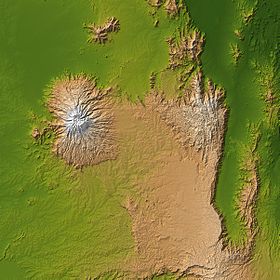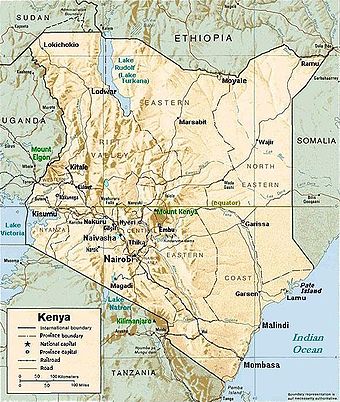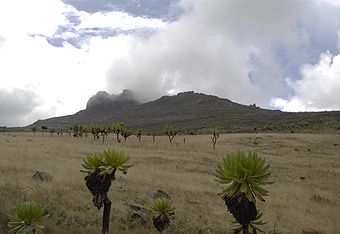- Mount Elgon
-
Mount Elgon 
Mount Elgon (left) and Great Rift Valley (right)Elevation 4,321 m (14,177 ft) Prominence 2,458 m (8,064 ft) Listing Ultra, Breast shaped hills Location Location Uganda-Kenya Coordinates 1°8′N 34°33′E / 1.133°N 34.55°ECoordinates: 1°8′N 34°33′E / 1.133°N 34.55°E Topo map Mount Elgon Map and Guide[1] Geology Type Shield volcano Age of rock Miocene origin Last eruption Unknown Climbing First ascent 1911 by Kmunke and Stigler Easiest route Scramble  Mount Elgon (left center) is located on the Uganda-Kenya border, in Western Province, north of Kakamega, west of Kitale.
Mount Elgon (left center) is located on the Uganda-Kenya border, in Western Province, north of Kakamega, west of Kitale.
- See also Mount Elgon District
Mount Elgon is an extinct shield volcano on the border of Uganda and Kenya,[2] north of Kisumu and west of Kitale.
Contents
Physical features
It is the oldest and largest solitary volcano in East Africa, covering an area of around 3500 km².[citation needed]
Other features of note are:
- The caldera — Elgon's is one of the largest intact calderas in the world
- The warm springs by the Suam River
- Endebess Bluff (2563m or 8408 ft)
- Ngwarisha, Makingeny, Chepnyalil and Kitum caves. Kitum Cave is over 60 metres wide and penetrates 200 metres. It is frequented by wild elephants who lick the salt exposed by gouging the walls with their tusks.[3] It became notorious following the publication of Richard Preston's book The Hot Zone in 1994 for its association with the Marburg virus after two people who had visited the cave (one in 1980 and another in 1987) contracted the disease and died.
The mountain soils are red laterite. The mountain is the catchment area for the several rivers such as the Suam River which becomes the Turkwel downstream and which drains into Lake Turkana, the Nzoia River and the Lwakhakha which flow to Lake Victoria. The town of Kitale is in the foothills of the mountain. The area around the mountain is protected by two Mount Elgon National Parks one on each side of the international border.
Some rare plants are found on the mountain, including Ardisiandra wettsteinii, Carduus afromontanus, Echinops hoehnelii, Ranunculus keniensis, and Romulea keniensis.[4]
In 1896, C. W. Hobley became the first European to circumnavigate the mountain. Kmunke and Stigler made the first recorded ascent of Wagagai and Koitobos in 1911. F. Jackson, E. Gedge, and J. Martin made the first recorded ascent of Sudek in 1890. The main peak is an easy scramble and does not require any special mountaineering skills.
Name
The mountain is named after the Elgeyo tribe, who once lived in huge caves on the south side of the mountain.[citation needed]
It was known as "Ol Doinyo Ilgoon" (Breast Mountain) by the Maasai and as "Masaba" on the Ugandan side.
Mt. Elgon consists of five major peaks:
- Wagagai (4,321m), being in Uganda.
- Sudek (4,302m or 14,140;ft) in Kenya
- Koitobos (4,222m or 13,851;ft), a flat topped basalt column (Kenya)
- Mubiyi (4,211m or 13,816;ft)
- Masaba (4,161m or 13,650;ft)
Mount Elgon is a massive solitary volcanic mountain on the border of eastern Uganda and western Kenya. Its vast form, eighty kilometers in diameter, rises 3070m above the surrounding plains, providing welcome relief in more than one sense of the word. Its mountainous terrain introduces variety to an otherwise monotonous regional landscape. Its cool heights offer respite for humans from the hot plains below and its higher altitudes provide a refuge for flora and fauna.
Local ethnicities
Mount Elgon is home to three tribes, the Bagisu, the Sabiny and the Ogiek, better known in the region under the derogatory umbrella term Ndorobo. The Bagisu and Sabiny are subsistence farmers and conduct circumcision ceremonies every other year to initiate young men (and in the Sabiny's case, girls) into adulthood. Traditionally, the Bagisu, also known as the BaMasaba, consider Mount Elgon to be the embodiment of their founding father Masaba, and you may hear the mountain called by this name. Local people have long depended on forest produce and have made agreements with the park to continue to harvest resources such as bamboo poles and bamboo shoots (a local delicacy). The Ogiek used to be hunters and honey gatherers, but have become more sedentary in recent decades, and have partially been moved downward by the government.
See also
- 2010 Uganda landslide
- List of volcanoes in Kenya
- Elgon languages
- Mount Elgon insurgency
- Breast shaped hills
Bibliography
- Scott, Penny (1998). From Conflict to Collaboration: People and Forests at Mount Elgon, Uganda. IUCN. ISBN 2-8317-0385-9.
References
- ^ EWP (1989). Mount Elgon Map and Guide (Map). 1:50,000 with mountaineering information (1st ed.). ISBN 0-906227-46-1. http://www.ewpnet.com/elgonmap.htm.
- ^ "Uganda Wildlife Authority". www.uwa.or.ug. http://www.uwa.or.ug/elgon.html. Retrieved 2008-03-16.
- ^ http://animal.discovery.com/fansites/wildkingdom/cave_elephants/field/field.html
- ^ http://www.tour-uganda.com/national-parks/uganda-national-parks/mt-elgon-nationl-park.html
Preston, Richard, The Hot Zone : The Terrifying True-Life Thriller, Bantam Books, 1994.
External links
Categories:- Mount Elgon
- Mount Elgon District
- Western Province (Kenya)
- Stratovolcanoes
- Volcanic calderas
- Mountains of Uganda
- Volcanoes of Uganda
- Mountains of Kenya
- Volcanoes of Kenya
- Volcanoes of the Great Rift Valley
- Extinct volcanoes
- Anthropomorphic geographic features
- Kenya–Uganda border
- International mountains of Africa
Wikimedia Foundation. 2010.

